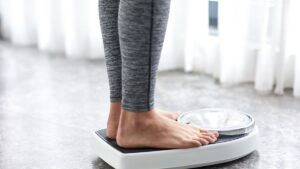One of the main concerns for people attempting to lose weight is losing muscle. Your fitness goals can be met, your workout performance can be improved, and your general health can be improved by preventing muscle loss. By sticking to a set of fitness regimens and dietary guidelines, you can reduce fat while also maintaining your muscle mass during your drive to shed pounds.
Why muscles are lost
It can be challenging, but it is a worthy goal to lose weight while maintaining mass of lean muscles, especially for your general health and wellbeing. In comparison to fat, lean muscle has a higher metabolic activity, which results in greater calories burned. Better mobility and improved cardiac and metabolic wellness are also provided by muscle, though it can be difficult to maintain.
Typically, our systems will first break down muscle cells for energy prior to moving on to fat. The process of converting fat into energy is more complex, so the body usually chooses to use the quick energy reserves in muscle.
Without increasing or losing muscle, it is still possible to burn body fat through exercise. It is necessary to make some adjustments to your food plans and exercise routines if you want to exercise to lose excess weight while maintaining a lean physique. Keep in mind that the best strategy for losing weight and retaining healthy muscle mass depends on your body shape.
Fat Loss Is Not The Same As Weight Loss
A drop in body weight that involves the loss of muscle, fat, and water is referred to as weight loss. It’s an effective and healthy weight reduction method, but it is also one that is often misunderstood; you may not even realize whether you are losing weight through muscle loss or fat loss.
As it specifically relates to lowering body weight, particularly fat, fat loss is much more precise than weight loss. A scale can be used to monitor your weight loss progress, but it does not reveal whether you have shed muscle or fat. An intramuscular fat scale, which provides precise fatty tissue and muscle proportions, provides a more accurate picture of the body’s constitution.
For determining whether much fat you have acquired or lost, skinfold calipers are a great alternative.
Your general health may suffer if you lose muscle mass because muscles are so important to the body. They control blood sugar and cholesterol levels and can prevent inflammatory response. Research has shown that chronic diseases including diabetes, cardiovascular disease, and metabolic disorders can result from carrying higher fat than muscle.
Muscle care can prevent age-related muscle loss, which is often associated with a risk of impairment or weakness. Also, keeping muscle mass boosts calorie burning when at rest, but doing the opposite might lead to body fat accumulation.
To accelerate weight reduction, you must eat less calories and follow a fitness regimen that can prevent muscle loss.
Must Read : Methods and time frame to reduce belly fat.
What Must You Do To Burn Fat?
Reducing overall calorie consumption is necessary to lose substantial amounts of body fat. Fat loss can be aided by calorie restriction and consistent exercise. Reducing weight without exercising might result in a harsh loss of muscle and fat. We should lose weight gradually because rapid weight loss frequently results in muscle loss.
You can make use of the advice provided here to reduce body fat while maintaining your lean muscle mass:
- Consumption of Protein
The immune responses, energy levels, digestive function, and electrolyte balance are all supported by proteins. Such nutrients are indeed essential for maintaining and growing muscular mass. You can reduce weight and gain muscle by increasing your protein intake while eating fewer calories.
- Exercise
Exercise speeds up fat removal and slows muscle loss. Exercising can help with fat loss as well as muscle development when coupled with a calorie-reduced diet. Cardiovascular exercise and muscular exercises both promote fat loss and muscle preservation in all the major muscle categories.
Aerobic exercises can also assist in fat loss. They can include activities like swimming, jumping rope, boxing, aerobics, and riding. Before engaging in any form of exercise or fitness routine, you should discuss any underlying medical conditions with your doctor.
Exercises that are part of resistance training include squats, pushups, and weightlifting. Avoid resistance training if you don’t want to gain weight because strength training typically includes weight training. In an effort to heal, it may also result in microtears that expose muscles to swelling.
- Reduce your calorie intake
Losing weight requires a calorie imbalance. Too much caloric restriction can cause muscle loss rather than fat loss. By consuming 500–600 calories per day, it is possible to avoid ceding muscle while also achieving fat reduction. Consuming processed food, starchy foods, whole grains, vegetables, fruits, fat free foods, and drinks with somewhat added sugar.
- Consuming Well
Eating healthfully can help you lose more weight. However, all dietary groups should be present in a balanced meal. Include fruits, lean protein, vegetables, essential fats, and meals high in fiber.
- Periodic fasting
It is possible to lose weight and maintain or even add muscle density by implementing intermittent fasting. Periods of not eating for a while, referred to as intermittent fasting, can promote metabolic rate and flexibility in metabolism. Your body’s ability to effectively switch across burning fat and carbohydrates as fuel is referred to as metabolic flexibility.
Also Read : Reduce body fat while maintaining your lean muscle mass.
How to retain muscle while reducing fat
When reducing weight by burning fat, it is possible to maintain muscle. You can implement the advice in the list below to reduce fat without losing muscle:
- Resist making extreme dietary changes
In the long run, abrupt meal restraints could be troublesome since it may be challenging to keep up.
- Engaging in workouts
This speeds up fat removal and slows muscle loss. Cardio and muscular exercises can both help you reduce fat and maintain muscle across each of your major muscle groups. Exercise can aid in fat loss as well as muscle growth when coupled with a calorie-restricted diet.
- Muscle Regeneration
After exercising, it’s crucial to give your muscles time to recover. If you are exercising vigorously while following a calorie-restricted way of eating, make sure to get enough relaxation so your body can replenish its energy.
- Avoid Excessive Exercise
Avoid exercise regimens that could leave you overly exhausted or hurt. Injuries or fatigue can result from pushing yourself too hard, which makes it challenging to continue exercising.
- Nutritional Supplements
Protein supplements can aid in weight reduction and stop muscle mass diminishing in the human body. In order to stop you from accumulating additional body fat resulting in increased weight, these supplements can regulate your hunger pangs and stop the growth and absorption of fat.
To decrease catabolism, the muscles require a steady flow of protein to develop and recuperate from exercise; target for a minimum of a single gram of protein for each pound of weight. By consuming fish, lean meat, and eggs with each meal, you can evenly distribute your daily protein intake.
Green peas, beans, lentils,tofu as well as other organic high-protein meals should be consumed in large quantities if you follow a diet that is entirely vegetarian or vegan.
- Appropriate water intake
Appropriate water intake can aid in weight and body fat reduction since water suppresses hunger naturally. It boosts metabolism, mitigates imbalances in electrolyte levels and lowers stress levels while on physical activity.
Observe caution
A more significant amount of muscle mass can be preserved when weight reduction is gradual but steady. One or two pounds of weight reduction per week can be achieved by reducing caloric intake with 500–1,000 calories per day. You run the risk of losing muscle if your caloric intake is further reduced.
Conclusion
Losing fat and keeping muscle can both be accomplished with cardio activities, low calorie intake and healthy eating. It does not have to be challenging to lose weight after months of shaping up. All you need is a strategy and the willpower to stick to it.
Every detail counts, from the timing of meals and the ratios of the macronutrients to the severity and length of workouts. You will not only gain those abs popped and experience impressive feelings, but you will also burn fat if you practice the course correctly.
FAQs:
- Is it possible to lose extra weight without cutting back on muscles?
Yes. Losing fat and keeping muscle can both be accomplished with cardio activities, low calorie intake, and healthy eating.
- Is it attainable to lift weights without gaining any muscle?
Yes. Lifting weights is one way to get a toned physique. If you do not want to gain strength, always ask a trainer for advice.
- What proportion of bodily fat is considered healthy?
This is dependent on variables like age and gender. For example, females between the ages of 20 and 39 should strive for 21–32%. The target range for men within the identical age category should be 8–19%.
- How soon will I see the outcome?
This is dependent on many variables, including your nutrition, exercise, effort level, and composition of the body.









